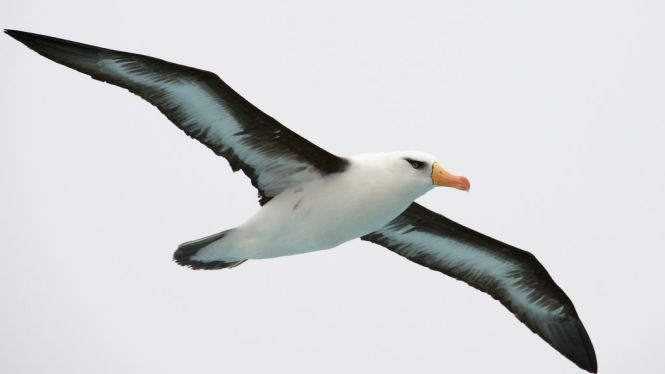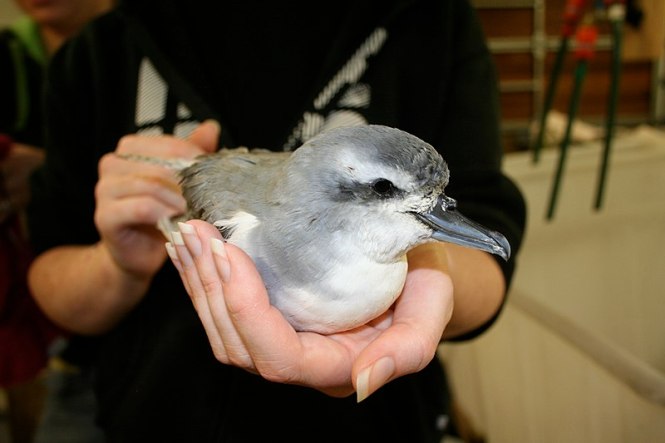The seabird order Procellariiformes comprises four families: albatrosses (Diomedeidae), petrels and shearwaters (Procellariidae), storm petrels (Hydrobatidae) and diving petrels Pelecanoidae). Hybridization is relatively common.
Hydrobates
The Band-rumped Storm-petrel (H. castro) species complex is comprised of several cryptic species. On several islands, there are genetically differentiated breeding populations that breed at different times of the year (Taylor et al., 2019).

The Band-rumped Storm-petrel © Luke Seitz | eBird
Thalassarche
Black-browed Albatross (Thalassarche melanophris) and New Zealand Black browed Albatross (T. impavida) interbreed on Campbell Island (Moore, Taylor & Amey, 1997), genetic analyses confirmed these observations (Burg & Croxall, 2001; Moore et al., 2001).
Hybridization between Black-browed Albatross and Shy Albatross (T. cauta) has also been reported (Clark & Robertson, 1996). On Bird Island, South Georgia, a genetic analysis revealed that two chicks were the result of hybridization between Black-browed Albatross and White-capped Albatross (T. steadi – sometimes considered a subspecies of T. cauta). A third chick was the outcome of extra-pair copulation (Phillips et al. 2018).

Black-browed Albatross (Thalassarche melanophris)
Phoebastria
Hybrids between Black-footed Albatross (Phoebastria nigripes) and Laysan Albatross (P. immutabilis) are known (Fisher, 1948; Fisher, 1972; McKee & Pyle, 2002; Rutt, 2013). A genetic study showed that hybridization is asymmetrical (always male P. nigripes) and probably rape is involved (Rohwer, Harris & Walsh, 2014).
The Short-tailed Albatross (P. albatrus) is a vulnerable seabird that mainly breeds on Torishima and the Senkaku Islands in the Pacific Ocean. The two populations are genetically distinct and display assortative mating. However, a study based on mate choice of ringed (from Torishima) and unringed birds (from the Senkaku Islands) revealed some mixed pairings, indicating that pre-mating isolation is incomplete (Eda et al., 2016).

Black-footed Albatross (Phoebastria nigripes)
Macronectes
Hybridization between Southern Great Petrel (Macronectes giganteus) and Northern Great Petrel (M. halli) have been documented (Burger, 1978; Johnstone, 1978). The incidence of interbreeding has also been reported (Hunter, 1983). Hybrids are fertile, as exemplified by a well-documented case of back-crossing (Brown et al., 2015).

Northern Great Petrel (Macronectes halli)
Pachyptila
Genetic and morphological analyses suggest that Salvin’s Prion (P. salvini) is a hybrid species between Antarctic Prion (P. desolata) and Broad-billed Prion (P. vittata). It is reproductively isolated from both parental species by allochrony (Masello et al., 2019).

Salvin’s Prion (P. salvini), a possible hybrid species.
Pterodroma
Based on microsatellites and song recordings, hybridization between Trindade Petrel (Pterodroma arminjoniana) and Kermadec Petrel (P. neglecta) on Round Island was documented (Brown et al., 2010). Phylogenetic analyses of all Petrel species from Round Island revealed that Trindade Petrel also hybridizes with Herald Petrel (P. heraldica). And although Kermadec Petrel and Herald Petrel breed sympatrically, there are no records of hybridization (Brown et al., 2011). A genetic study including five Pterodroma species showed that gene flow is not limited to Round Island, but occurs on a global scale, even across populations from different oceans (Booth Jones et al., 2017).
Finally, Tennyson et al. (2013) identified a hybrid between White-headed (P. lessonii) and Soft-plumaged (P. mollis) Petrel, based on morphology and mtDNA.

Trindade Petrel (Pterodroma arminjoniana)
Puffinus
Genetic studies showed that Balearic Shearwater (Puffinus mauretanicus) and Yelkouan Shearwater (P. yelkouan) interbreed (Genovart et al., 2012; Genovart, Juste & Oro, 2005; Genovart et al., 2007). Acoustic analyses showed that, for both sexes, calls have species- specific characteristics while hybrids have intermediate acoustic features compared to their parental species (Cure, Aubin & Mathevon, 2010).

Balearic Shearwater (Puffinus mauretanicus)
References
Booth Jones, K. A., Nicoll, M. A., Raisin, C., Dawson, D. A., Hipperson, H., Horsburgh, G. J., et al. (2017). Widespread gene flow between oceans in a pelagic seabird species complex. Molecular Ecology 26, 5716-5728.
Brown, R. M., Jordan, W. C., Faulkes, C. G., Jones, C. G., Bugoni, L., Tatayah, V., Palma, R. L. & Nichols, R. A. (2011). Phylogenetic Relationships in Pterodroma Petrels Are Obscured by Recent Secondary Contact and Hybridization. PLoS ONE 6.
Brown, R. M., Nichols, R. A., Faulkes, C. G., Jones, C. G., Bugoni, L., Tatayah, V., Gottelli, D. & Jordan, W. C. (2010). Range expansion and hybridization in Round Island petrels (Pterodroma spp.): evidence from microsatellite genotypes. Molecular Ecology 19, 3157-3170.
Brown, R. M., Techow, N. M. S. M., Wood, A. G. & Phillips, R. A. (2015). Hybridization and Back-Crossing in Giant Petrels (Macronectes giganteus and M. halli) at Bird Island, South Georgia, and a Summary of Hybridization in Seabirds. Plos One 10.
Burg, T. M. & Croxall, J. P. (2001). Global relationships amongst black-browed and grey-headed albatrosses: analysis of population structure using mitochondrial DNA and microsatellites. Molecular Ecology 10, 2647-2660.
Burger, A. (1978). Interspecific breeding attempts by Macronectes giganteus and M. halli. Emu 78, 234-235.
Clark, G. & Robertson, C. (1996). New Zealand White-capped Mollymawks (Diomedea cauta steadi) breeding with Black-browed Mollymawks (D. melanophrys melanophrys) at Antipodes Islands, New Zealand. Notornis 43, 1-6.
Cure, C., Aubin, T. & Mathevon, N. (2010). Intra-sex vocal interactions in two hybridizing seabird species (Puffinus sp.). Behavioral Ecology and Sociobiology 64, 1823-1837.
Eda, M., Izumi, H., Konno, S., Konno, M. & Sato, F. (2016). Assortative mating in two populations of Short‐tailed Albatross Phoebastria albatrus on Torishima. Ibis 158, 868-875.
Fisher, H. (1948). Interbreeding of Laysan and Black-footed albatrosses. Pacific science 2, 132.
Fisher, H. I. (1972). Sympatry of Laysan and black-footed albatrosses. The Auk, 381-402.
Genovart, M., Juste, J., Contreras-Diaz, H. & Oro, D. (2012). Genetic and Phenotypic Differentiation between the Critically Endangered Balearic Shearwater and Neighboring Colonies of Its Sibling Species. Journal of Heredity 103, 330-341.
Genovart, M., Juste, J. & Oro, D. (2005). Two sibling species sympatrically breeding: a new conservation concern for the critically endangered Balearic shearwater. Conservation Genetics 6, 601-606.
Genovart, M., Oro, D., Juste, J. & Bertorelle, G. (2007). What genetics tell us about the conservation of the critically endangered Balearic shearwater? Biological Conservation 137, 283-293.
Hunter, S. (1983). Interspecific breeding in giant petrels at South Georgia. Emu 82, 312-314.
Johnstone, G. (1978). Interbreeding by Macronectes halli and M. giganteus at Macquarie Island. Emu 78, 235-235.
Masello, J. F., Quillfeldt, P., Sandoval-Castellanos, E., Alderman, R., Calderón, L., Cherel, Y., Cole, T.L., Cuthbert, R.J., Marin, M., Massaro, M., Navarro, J., Phillips, R.A., Ryan, P.G., Shepherd, L.D., Suazo, C.G., Weimerkirch, H. & Moodley, Y. (2019). Additive traits lead to feeding advantage and reproductive isolation, promoting homoploid hybrid speciation. Molecular Biology and Evolution. msz090.
McKee, T. & Pyle, P. (2002). Plumage variation and hybridization in Black-footed and Laysan Albatrosses. North American Birds 56, 131-138.
Moore, P. J., Burg, T. M., Taylor, G. A. & Millar, C. D. (2001). Provenance and sex ratio of Black-browed Albatross, Thalassarche melanophrys, breeding on Campbell Island, New Zealand. Emu 101, 329-334.
Moore, P. J., Taylor, G. A. & Amey, J. M. (1997). Interbreeding of black-browed albatross Diomedea m-melanophris and New Zealand black-browed albatross D-m-impavida on Campbell Island. Emu 97, 322-324.
Phillips, R.A., Cooper, J. & Burg, T.M. (2018) Breeding-site vagrancy and hybridization in albatrosses. Ibis
Rohwer, S., Harris, R. B. & Walsh, H. E. (2014). Rape and the prevalence of hybrids in broadly sympatric species: a case study using albatrosses. PeerJ 2, e409.
Rutt, C.L. (2013) Hybridization of the Black-footed and Laysan albatrosses. Western Birds 44, 322-333.
Taylor, R. S., Bolton, M., Beard, A., Birt, T., Deane-Coe, P., Raine, A. F., Gonzalez-Solis, J., Lougheed, S. C. & Friesen, V. L. (2019). Cryptic species and independent origins of allochronic populations within a seabird species complex (Hydrobates spp.). Molecular Phylogenetics and Evolution, 139:106552.
Tennyson, A., Lawrence, H., Taylot, G. & Imber, M. (2013). A hybrid gadfly petrel suggests that soft-plumaged petrels (Pterodroma mollis) had colonised the Antipodes Islands by the 1920s. Notornis 60, 290-295.
[…] Procellariiformes […]
[…] The Short-tailed Albatross (Phoebastria albatrus) is a vulnerable seabird that mainly breeds on Torishima and the Senkaku Islands in the Pacific Ocean. The two populations are genetically distinct and display assortative mating. However, a study based on mate choice of ringed (from Torishima) and unringed birds (from the Senkaku Islands) revealed some mixed pairings, indicating that pre-mating isolation is incomplete (Eda et al., 2016). […]
[…] Procellariiformes […]
[…] Procellariiformes […]
[…] Procellariiformes […]
[…] Procellariiformes […]